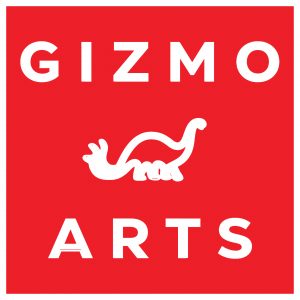Diasporic Deities
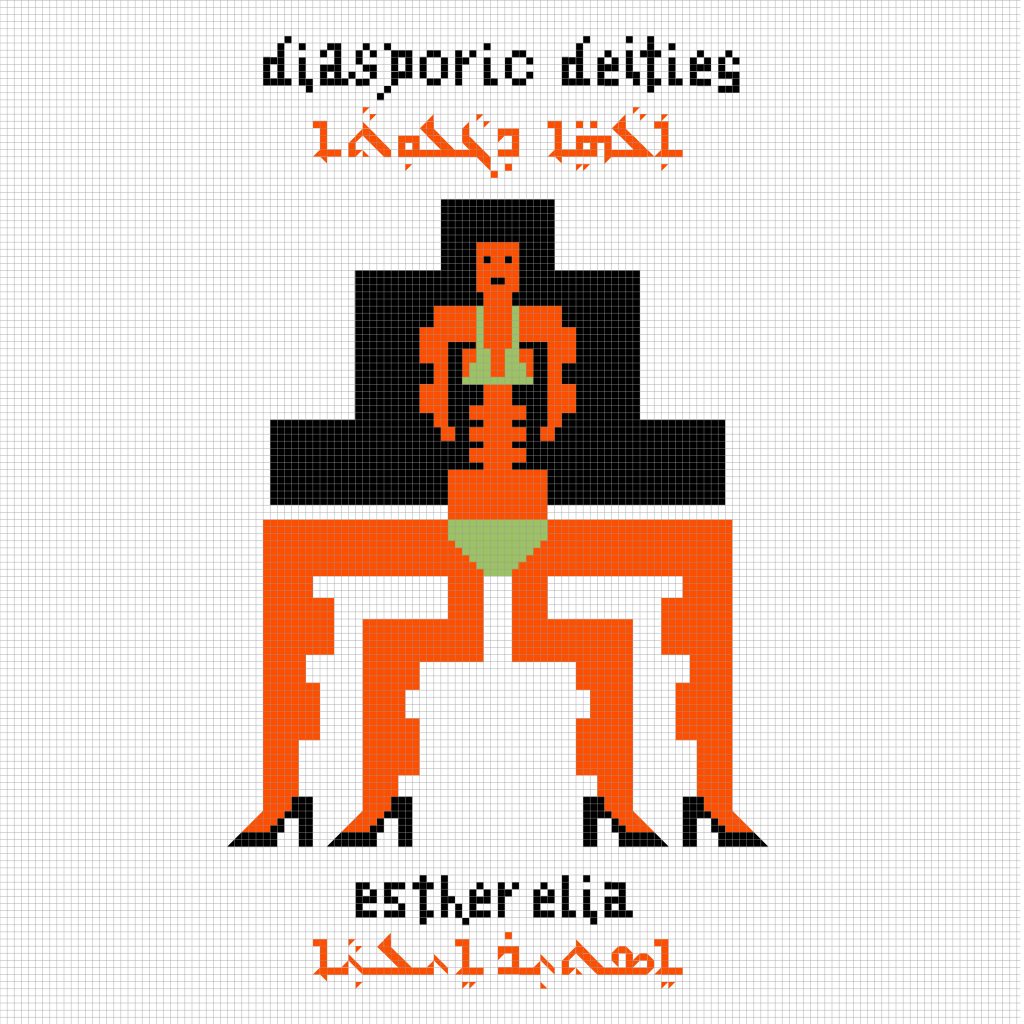
Diasporic Deities
Esther Elia
February 3-24, 2023
Opening: February 3, 5-8 pm
Zuyakha/Celebration:
Saturday, February 4, 5:30
*Performance starts at 6:00 pm with traditional Assyrian food and dancing.
Sanitary Tortilla Factory is pleased to present Diasporic Deities by UNM College of Fine Art’s MFA Candidate and Exceptional Visual Art Scholar (EVAS) Awardee Esther Elia. EVAS is a series that offers professional space for Master of Fine Art graduate students as their final thesis show. The culminating exhibition launches them into their profession as an artist. With the series, we underscore exceptional artists attending regional institutions while highlighting Albuquerque’s innovative contemporary art scene.
If one were looking for an Assyrian, they are most easily found in the Met, the British Museum, and the Louvre, most likely correcting unwitting docents who casually referred to Assyrians in the past tense. The Assyrian Indigenous homeland is the intersection of modern-day Turkey, Syria, Iran, and Iraq. Many years ago, museums were built to house the fantastic treasures of our monumental carved lamassu that were originally stationed outside of Assyrian cities like Nineveh. Unearthed bas reliefs that lined palace walls and portrayed the victories of the Assyrian kings Sargon, Sannacherib, and Ashurbanipal were taken from the land of their conception and transplanted, a sort of prophecy of what was to come for the Assyrian people themselves. These sculptures spoke to the Western imagination, a tale of the great kingdoms of the past, and created a folklore of a time and people they decided must be long gone.
So what of the living, breathing Assyrians? Today they are a religious and ethnic minority, survivors of multiple genocides throughout the 19th and 20th centuries, scattered across the world in tight-knit communities within their Indigenous homelands and diaspora.
This is the basis of the monumental sculptures and large-scale paintings shown in Esther Elia’s MFA Thesis Exhibition, Diasporic Deities. Through the use of material and the visual impacts of diaspora, Elia documents the next phase of the Assyrian identity. While ancient Assyrian art documented the deities that were born out of the Mesopotamian landscape, Elia imagines how these deities have shifted in diaspora. They take on new faces, new occupations – rooted in homeland, and yet evolving to reflect the needs of a generation exiled from their Indigenous home. These “new deities” also echo the fertility goddesses that we carried around with us in the past, their exaggerated features showing up in new ways with multiple limbs, muscles, and bodybuilder competition bikinis. In essence, our strength becomes exaggerated, for we are in less need of fertility and in more need of muscle. These grandchildren of our pantheon are portraits of our women stolen, and our nation’s fertility co-opted most recently by the ISIS invasions. These tiled structures stand strong, winged, multi-limbed, and muscular – the new protective deities for the contemporary Assyrian.
Artist Bio:
Esther Elia was born and raised in Turlock, California. She received a BFA in Illustration from California College of the Arts in 2019, and is currently finishing a Masters of Fine Arts in Painting/Drawing from the University of New Mexico. Her work focuses on the Assyrian experience, the maintaining and creation of culture in diaspora, and revitalizing Assyrian ritual practices through sculpture and large-scale paintings. She, along with other Assyrian visual artists, are working to combat the notion that Assyrian Art can and does only exist within the ancient past by collecting and displaying contemporary oral histories, painting living Assyrian faces, speaking and examining the Assyrian language, and documenting Assyrian culture as it continues to grow and shift both in our indigenous homeland and diaspora.
Her work has focused in the past on the refugee experience, and addresses more broadly the mindset that is obsessed with the pursuit of safety. In her new series of diasporic deities, she draws from the grid of the rug and cultural practices of tiling to create blocky sculptures that reference Afghan war rugs. Just as villages documented unfamiliar Soviet weapons of war in their kilims, so I too am combining the new with the old, my diasporic environment showing up and taking shape within ancient references. Esther’s work has been shown in the deYoung museum, she has done murals in Iraq and California Facebook offices, was accepted to participate in the 2022 Guggenheim Summer College Workshop, and has most recently won the 2022 Assyrian Academic Research Grant for her project The Assyrian Prayer Bowl Archive.
La Eterna Injusticia
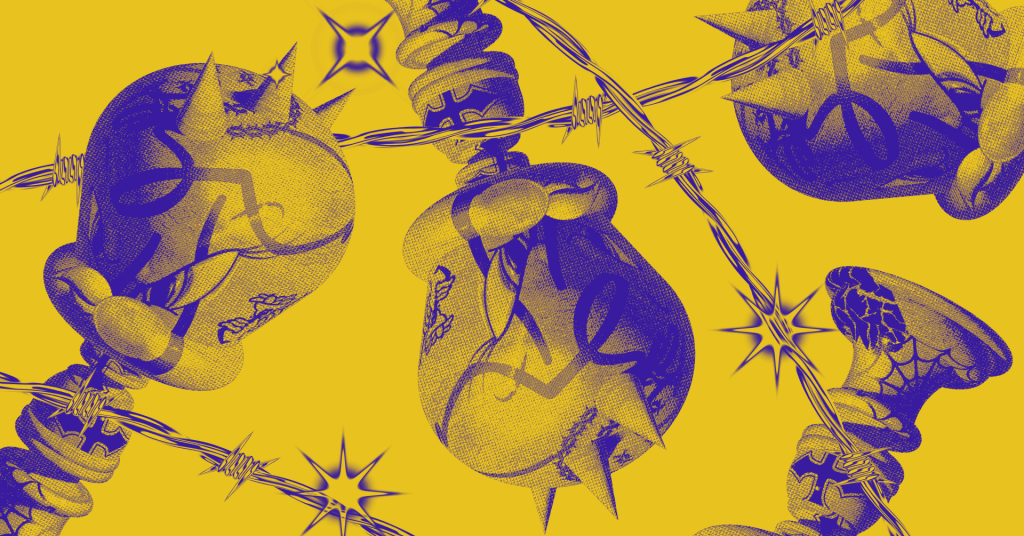
La Eterna Injusticia
Martín Wannam
January 6 – January 27, 2023
Reception: Friday, January 6, 5-8:30 pm
Sanitary Tortilla Factory proudly presents La Eterna Injusticia by Martín Wannam. This exhibition reflects on the power of monuments by questioning the ideologies they can reinforce. The brown silhouettes in each portrait takes the place of the monuments in Guatemala City with violent, oppressive histories, especially in relation to the LGBTQ+ community. Removing the iconography and placing the brown silhouette in its place creates an intervention that asks the viewer to reimagine each monument’s power through a queer lens. By combining a variety of popular culture references and textures in each artwork, a maximalist anti-aesthetic is created. The concept of monumentality is also present in the video installation. Each performer becomes a moving monument and the audience becomes a participant in the work as they partake in the spectacle. The exhibition asks, what would a queer utopia look like? What, or who would be idolized through a monument?
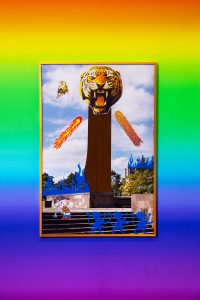
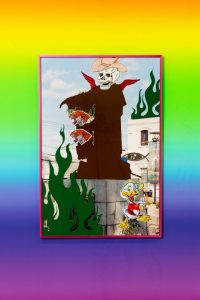
Artist Bio
Martín Wannam (b. 1992, Guatemala) is a visual artist and educator whose work looks critically at the historical, social, and political climate of Central America, specifically examining its impact on the queer individual. He focuses on the intersection of brownness and queer utopia,using the tools of photography, sculpture, and performance. Working from the premise of iconoclasm, he enacts a constant evaluation of systematic structures such as religion, coloniality, folklore, and white supremacy.
He received his MFA in Photography from the University of New Mexico in the Spring 2020, a Diploma in Contemporary photography from La Fototeca (GT) in 2016, and a BA in Graphic Design from the Universidad Rafael Landivar (GT) in 2015. Wannam has exhibited nationally and internationally, including various group and solo shows in Guatemala, The United States, Rotterdam, Netherlands, and Korea. Wannam is the recipient of a Special Mention in the category Series in PHOTO PRIDE 2020, Fulcrum Fund 516 (2020), Coke Newhall Photo Fellowship (2020), MaryAnn Evans Grant (2019), SPE Student Award for Innovations in Imaging (2018), and Site Scholar (2018-2019). Currently, he is an Assistant Professor in Studio Art at UNC Chapel Hill and part of the Fronteristxs Collective.
Happy Time/Doomsday Time
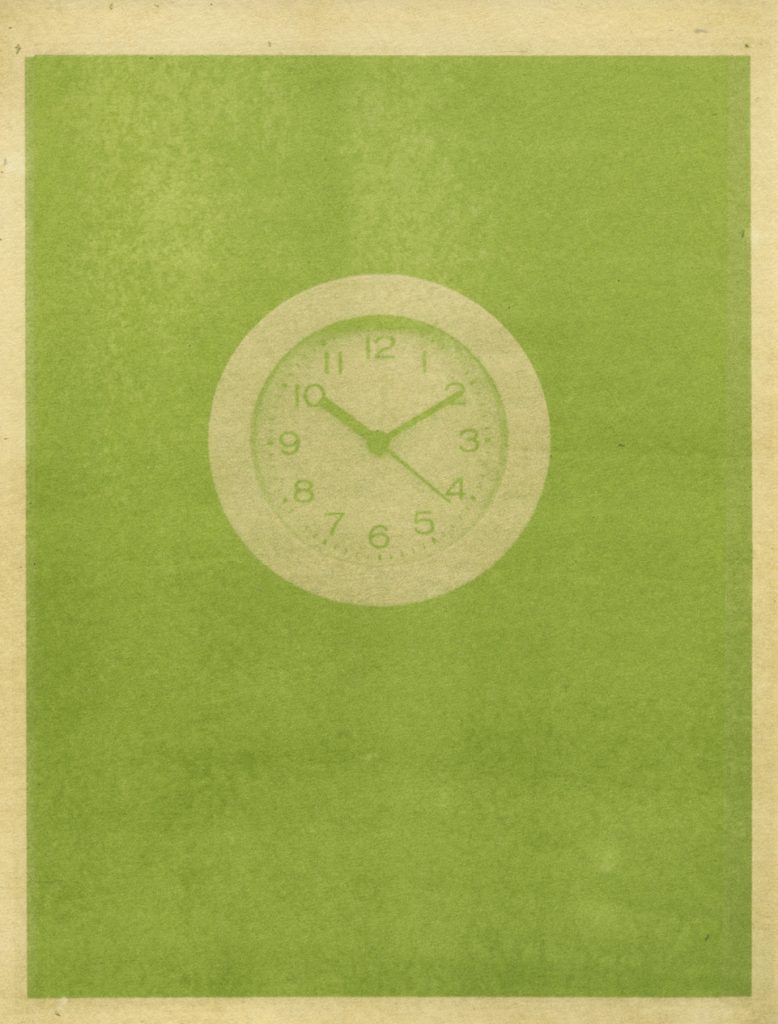
Happy Time/Doomsday Time
Meggan Gould
November 4 – 25, 2022
Opening Reception: Friday, November 4, 5-8 pm
Sanitary Tortilla Factory is proud to present Happy Time/Doomsday Time by Meggan Gould. In the scope of the history of photography, the anthotype (flower print) figures as little more than a footnote, with a metaphorical pat on the head (endearing, though unlikely to mature!). Plant materials form the emulsions for this crude printing method: berries, petals, and leaves are crushed or pulverized to stain paper. Exposed though objects or printed material in a contact printing frame, sunlight slowly bleaches an image into existence on the dyed substrate.
As a process, this plant-based printing is both impossible to standardize for commercial distribution and unfixable—not one, but two death knells for an industrialized photographic practice. And a third: tedious exposure times make it impractical for most of the medium’s needs, as they have come to be understood.
As they have come to be understood. Our relationship to photography itself, to both the instantaneity of capture and any presumption of permanence, may need to change as we hover on the precipice of environmental catastrophe. Could the humble anthotype represent our future (gentle, fugitive) experience of photography? Can fading bring joy?
My current obsession focuses on a clock, mostly stuck at 10:10 – as in all watch/clock advertisement. This form of the hands allows the brand name to be framed, with the optimism of a subtle smile form (affectionately known as “Happy Time”). I am fascinated by the tropes of the photographic medium and the assumptions we make in its practice, the ways our vision is quietly mediated. My quest to push against default printing processes figures into the same conversation, for me, as that of this insidious clock time. The occasional Doomsday Clock image joins the mix, stuck ominously at 100 seconds to midnight.
Artist Bio
Meggan Gould is a photographer living and working in the mountains outside of Albuquerque, New Mexico, where she is an Associate Professor of Art at the University of New Mexico. She is a graduate of the University of North Carolina at Chapel Hill, where she studied anthropology, the SALT Institute for Documentary Studies, where she studied non-fiction writing, and Speos (Paris Photographic Institute), where she finally began her studies in photography. She received an MFA in photography from the University of Massachusetts – Dartmouth. Her photographs have been featured in solo and group exhibitions throughout the United States and internationally.
A Companion for Departure
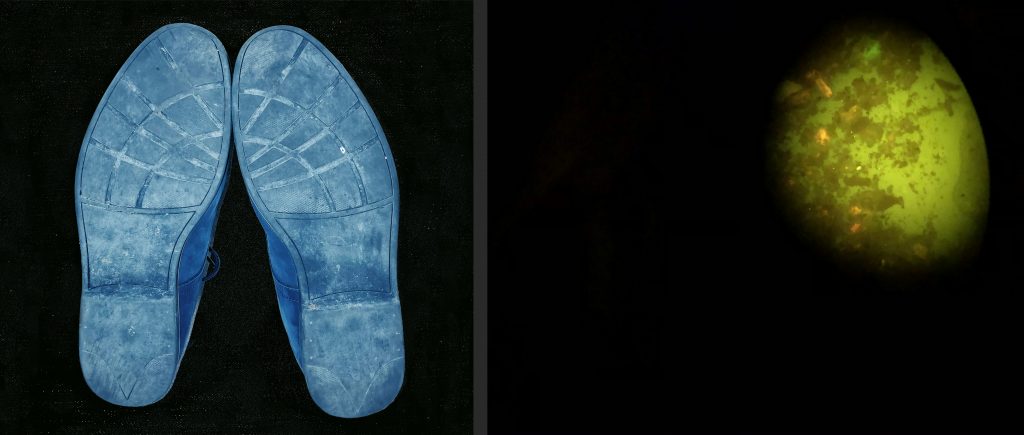
A Companion for Departure
Billy Joe Miller and Bethany Springer
October 8 – 29, 2022
Opening Reception: Saturday, October 8, 5-8 pm
Closing Reception: Saturday, October 29, 5-8 pm featuring Poet Lauren Camp
Sanitary Tortilla Factory is pleased to announce a new visual arts exhibition entitled A Companion for Departure by Billy Joe Miller and Bethany Springer. A Companion for Departure will be on display October 8th – October 29th with viewing hours Thursdays and Fridays, 12 pm-5 pm. Opening and closing receptions celebrating Springer and Miller’s A Companion for Departure will take place Saturday, October 8th from 5 – 8 pm and Saturday, October 29th from 5 – 8 pm. Poet Lauren Camp will contribute to the closing reception of a public reading of work that is produced from a collaborative exchange of ideas positing A Companion for Departure. This reception is free and open to the public.
In this collective moment of vulnerability, Springer and Miller lose themselves to embark on a shared journey that bridges the familiar and unfamiliar, seeking points of contact between the enigmatic terrain of the body, mortality, and a projected home in outer space.
In a series of conversations spanning over a year, the artists shared experiences that ultimately and profoundly shaped the creation of work. These call-and-response discussions mined the limitations and possibilities of the body, thresholds of loss and resurrection, increasing competition for natural resources held by a planet in crisis, and wonder for the mysteries of the universe as they unfold. Music perpetually materialized as a point of departure and arrival – as a result, song lyrics are woven through the exhibition. Deciphering what was found, the created works coexist as coordinates in a synthesized map, as companions in a metamorphosis processing historical space, memorials, time capsules and artifacts in their wake.
Artist Bios
Bethany Springer received an MFA in Sculpture from the University of Georgia and holds a Modern Dance minor from Virginia Tech. She is the recipient of a Pollock-Krasner Foundation Grant, Individual Fellowships from the Arkansas and Iowa Arts Councils, and a Community Research Award from the UA Community and Family Institute. She has been in residence at Full Tilt Creative Centre and Terra Nova National Park in Newfoundland, The Arctic Circle in Svalbard, the Fine Arts Work Center, Bemis Center for Contemporary Arts, Tides Institute & Museum of Art, and Marble House Project among others. Exhibition venues include 21C Museum Hotel, Maryland Art Place, Boston Center for the Arts, the Delaware Contemporary, LHUCA, and most recently as a contributor to the Personal Structures exhibition at the 2022 Venice Art Biennale. Springer currently lives and works in Fayetteville, Arkansas and is an Associate Professor in Sculpture + Experimental Media at the University of Arkansas.
Billy Joe Miller is a self-taught interdisciplinary artist who creates sculptures, installations, and public art in response to the natural world. The themes of belonging, shelter, and sanctuary are integral to his work. As a hospice nursing assistant for many years, Miller accompanied people through the process of dying. His experiences in healthcare-related sites, as well as his diagnosis of multiple sclerosis in 2010, have inspired his desire to create accessible public art for parks, community centers, medical clinics, and hospitals. Originally from San Diego, California, Miller now lives in the East Mountains of Albuquerque, New Mexico. In addition to his studio practice, Miller creates collaborative community-based projects and produces public art. His work has been supported by New Mexico Arts, the Andy Warhol Foundation for the Visual Arts, Meow Wolf, Bridge Projects, The Speranza Foundation, City of Palm Desert, and the National Endowment for the Arts.
Wires Under Tension by Dylan McLaughlin
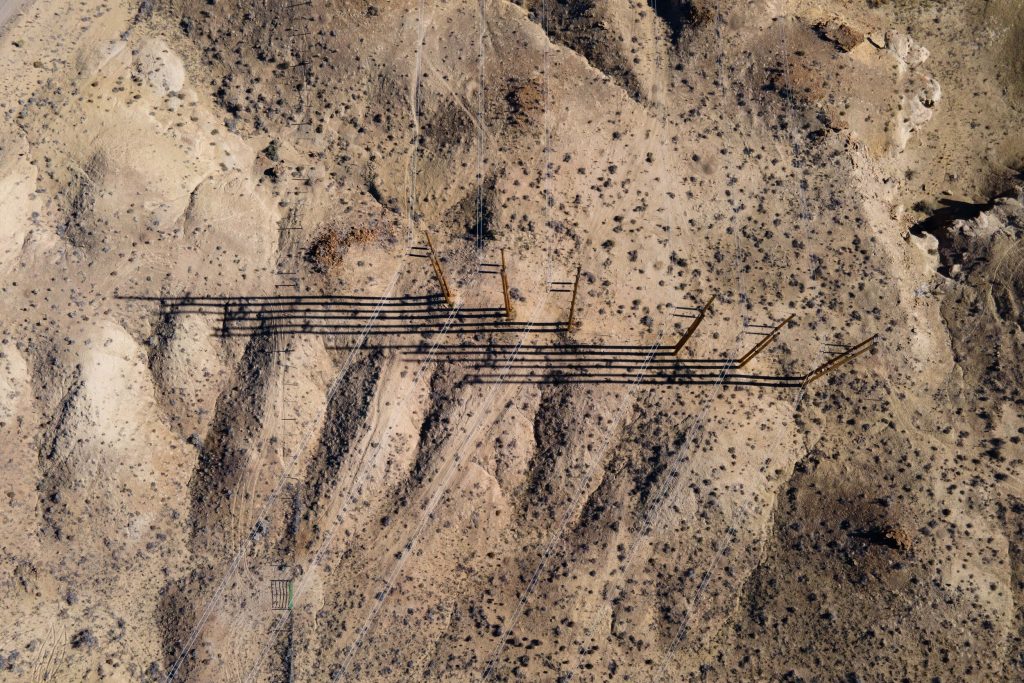
Wires Under Tension
September 2 – September 30, 2022
Reception: Friday, September 2, 5-8pm
Through sculptural sound installation and experimental music composition, Dylan McLaughlin’s new exhibition Wires Under Tension provides sonified meditations on stories of eco-violence and climate threatened place. The exhibition gives space to hear and feel warning signs of drought and die-off, as well as experience material investigations of disruptive communication technologies and sonic eco-violence. One work manipulates recorded sounds of bark beetle infested trees illuminating conversations about the effects of climate change on the Piñon Pine. Another makes audible the resilient calls of the endangered Piñon Jay, experiencing habitat loss. In this work, violence and beauty are not presented starkly. The sound of Bark beetles move from harsh hum to delicate sparse space, while fracking field recordings become an oppressive meditation. Wires Under Tension brings into conversation the magnitude and influence of the acoustic world, in its vulnerability, influence, resistance, adaptation, and transformation.
Bio:
Dylan McLaughlin (b. Navajo Nation) is a sound and video artist living and working in New Mexico. Looking critically to ecologies of extraction, his work weaves Diné mythology, open source ecological data, and environmental histories while holding space for complexity. What transpires is the sonification of relationships to land through experimental music composition, improvised performance, and meditations of new forms of cartography and viewing land. In his multi-media installation and performative works, McLaughlin looks to engage the poetics and politics of human relations to place. McLaughlin is a recipient of the Fulcrum Fund, and has done residencies at Mass MoCA, Slow Research Lab, and BOXO projects. He received his BFA in New Media Art from the Institute of American Indian Arts, and completed his Master of Fine Arts in Art & Ecology at the University of New Mexico in 2021.
